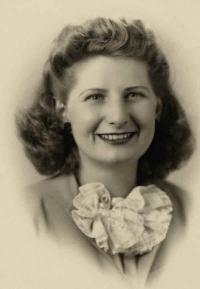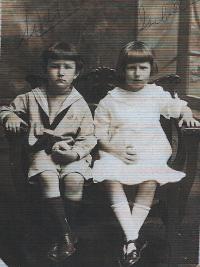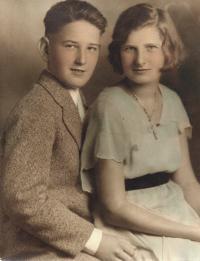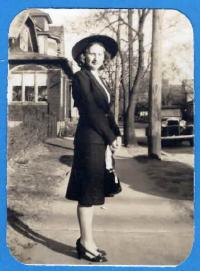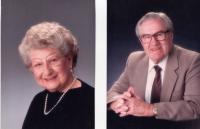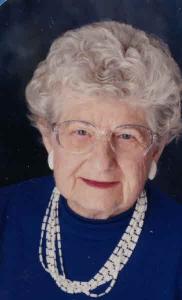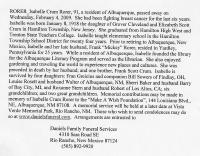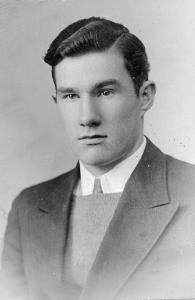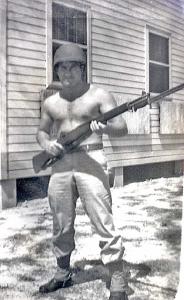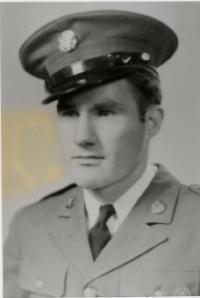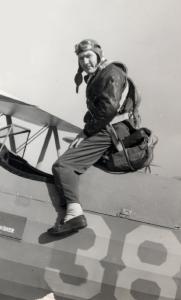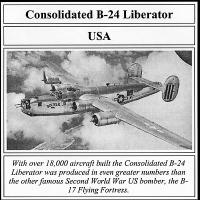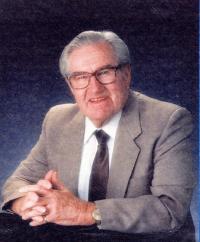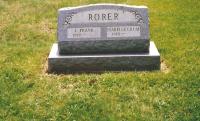Isabelle Maidie Crum
F, #1375, b. 8 January 1918, d. 4 February 2009
| Father | Grover Cleveland Crum b. 17 Dec 1887, d. 27 Apr 1975 |
| Mother | Mary Elizabeth Scott b. 16 Oct 1892, d. 5 Jul 1970 |
| Charts | Descendant Chart (Box) Descendant Chart (Indented) |
| Last Edited | 5 May 2018 |
| Birth* | 8 January 1918 | Isabelle Maidie Crum was born on 8 January 1918 in the family home on Norway Avenue, Hamilton Township, NJ.1 |
| She was the daughter of Grover Cleveland Crum and Mary Elizabeth Scott. | ||
| Namesake* | It is interesting to see how the name of Isabelle (Isabella) has come down at least five generations on both sides of the Atlantic. Isabelle was named for her grandfather's sister, Isabella Scott. Isabella Scott was named for her grandmother, Mary Isabella Borrowscale Scott of Cockermouth, Cumberland England. In addition to Isabelle Crum Rorer, born 1918 in New Jersey, there is Isabella Scott Bell, born 1916 in Cockermouth. These third cousins are both great, great granddaughters of Mary Isabella Borrowscale Scott, born in 1791. | |
| (Child with parents) 1920 Census | 10 January 1920 | She appeared on the 1920 Federal Census of 211 Norway Avenue, Hamilton Township, Mercer, NJ in the household of her parents, Grover Cleveland Crum and Mary Elizabeth Scott.2 in the household of her parents, Grover Cleveland Crum and Mary Elizabeth Scott.2 |
| (Witness) Reunion | circa 3 November 1924 | Six year old Isabelle and her father attended the Crum Family Reunion hosted by Isaac and Maggie Crum in honor of Isaac's brother, Daniel, who was visiting the East for the first time since moving to Kansas 47 years earlier.3 |
| Compiler's Comment | Isaac and Daniel Crum were Cleve Crum's uncles and Isabelle's great-uncles. | |
| Event-Misc* | February 1926 | At age 8, Isabelle participated in a water pagent entitled the "Giants Garden" at the 'Y' swimming pool.4 |
| Event-Misc | January 1933 | At a meeting of the Intermediate Society of the Westminster Presbyterian Church, 15 year old Isabelle was elected Secretary.5 |
| Education* | 18 June 1935 | On 18 June 1935, Isabelle graduated from Hamilton High School, Hamilton Township, Mercer, NJ at the age of 17.6 at the age of 17.6 |
| Event-Misc | 16 April 1936 | Ten months later, Isabelle was appointed to the social committee of the Young People's Society of the Westminster Presbyterian Church.7 |
| Event-Misc | November 1936 | On a sadder note, Isabelle was one of the honorary pall bearers at the funeral of Jeanette Welch held in November 1936.8 |
| Compiler's Comment* | Jeanette, who was only twenty at the time of her death, must have been dearly loved by Isabelle: the middle name of her first child, Frances Jean, was in honor of Jeanette. | |
| Event-Misc | June 1938 | As of June 1938, Isabelle was on the Program Committee for the annual Children's Day at the Westminster Presbyterian Church.9 |
| Compiler's Comment | 22 September 1939 | She received a Bachelor of Science degree from the State Teachers College at Trenton (currently known as the College of New Jersey) in 1939. Her degree enabled her to teach first through eighth grade. Isabelle had wanted to be a Latin teacher. The colleges that trained teachers in New Jersey specialized in particular areas. The college at which language education was taught was not close to Isabelle's home. Attending that college would have required Isabelle to room at the school. Money was too scarce for Isabelle to attend any other college than the one in her hometown. The programs offered at her local college were to train teachers of music, elementary education and business education. Isabelle had to give up her dream of being a Latin teacher and majored in elementary education. She was certified in the State of New Jersey on 22 Sept 1942, after teaching for three years.(Her college diploma and New Jersey Teacher Certification are in the files of the compiler.) |
| Marriage* | 1 January 1940 | She married Laurence Frank Rorer, son of Harry Closson Rorer and Emily McGookin, on 1 January 1940 at Warrenton, Fauquier, VA .10 .10 |
| Compiler's Comment | Isabelle and Mickey kept their marriage secret. After the marriage license was issued, they returned to live with their respective parents. One of the main reasons their marriage was secret was because married women could not be employed as teachers. The public felt these jobs should be given to men who were supporting families, not to women who already had a wage earner in the home. Isabelle wanted to become tenured. She kept her marriage secret until she received tenure. | |
| (Child with parents) Census 1940 | 16 April 1940 | Consequently, Isabelle Maidie Crum appeared on the 16 April 1940 Federal Census of 23 Norway Avenue, Hamilton Township, Mercer, NJ in the household of her parents, Grover Cleveland and Mary Elizabeth. She was listed as single and a teacher in the public schools.11 in the household of her parents, Grover Cleveland and Mary Elizabeth. She was listed as single and a teacher in the public schools.11 |
| Event-Misc | December 1940 | In Dec 1940, Isabelle was teaching at the Kuser School where she was on the arrangements committee for the Parent-Teacher Association's annual Christmas Party.12 |
| Event-Misc | June 1941 | In June 1941,"Isabelle Crum's first grade won the attendance award" at the final meeting of the season of the Kuser Parent-Teacher Association.13 |
| Event-Misc | December 1941 | Not only was Isabelle pursuing her career as a teacher, but she remained active in her church. She was on the Program Committee for the annual Christmas Treat at the Westminster Presbyterian Church in December 1941.14 |
| Event-Misc | October 1942 | She and Margaret Campbell were in charge of the beginners church school at the Westminster Presbyterian Church.15 |
| Event-Misc | March 1943 | "A leave of absence was granted Miss Isabelle Crum, teacher of first grade in Kuser School."16 |
| Compiler's Comment | Isabelle had received tenure 22 Sep 1942. She took a leave of absence so she could join Mickey in Phoenix, AZ where he was an Army Air Corps cadet. Air Corps cadets were not allowed to be married while they were in training. As soon as many of the cadets received their wings, they married their sweethearts. Mickey and Isabelle followed this pattern. | |
| Marriage | 15 April 1943 | She married Laurence Frank Rorer on 15 April 1943 at Phoenix, AZ , for the second time. This wedding was announced to family and friends and to the Army Air Corps.17 , for the second time. This wedding was announced to family and friends and to the Army Air Corps.17 |
| Compiler's Comment | After Mickey was sent overseas in the fall of 1944, Isabelle returned to Trenton and resumed her teaching career in Hamilton Township. Isabelle's mother, Libby Crum, took care of the infant Frances during the day. When Mickey returned from serving in Italy, Isabelle resigned her teaching position in order to stay home and raise her daughter, Frances. A second daughter, Louise, was born while the couple resided on Joan Terrace, Trenton. The family then moved to Sellersville, Bucks, PA where Mickey opened his Ford Dealership. A third daughter, Sherri, joined the family. Soon after Sheri's birth, the growing family moved to Quakertown because Mickey had moved his Ford dealership a few miles north on Route 309. The final child, Roxanne, was born to the family shortly before they moved to Yardley. Mickey had sold his successful dealership and purchased a Studebaker-Packard franchise in Trenton. Isabelle resumed her teaching career in 1962 and taught for a total of 24 years in the Hamilton Township, NJ. school system. She did an admirable job of teaching while also caring for her family of four daughters and husband. | |
| Compiler's Comment | Isabelle and Mickey retired to Albuquerque. After having lived in the desert in Phoenix during the war, Isabelle had always wanted to return to the warm, sunny, dry climate. When two of her daughters settled in Albuquerque, Issy had the perfect excuse to move to the Southwest. While living in Albuquerque, she volunteered as the librarian for the Literary Volunteers of America (LVA). LVA's mission was to tutor adults who had never learned to read. She also had an interest in gardening. Isabelle won an award from her homeowner's association for the plantings she had nurtured in front of her garden wall. | |
| Death* | 4 February 2009 | She died on 4 February 2009 at 808 Hackberry Trail SE, Albuquerque, Bernalillo, NM , at age 91. The cause of death was breast cancer which had been diagnosed when she was 85.18 , at age 91. The cause of death was breast cancer which had been diagnosed when she was 85.18 |
| Obituary* | See photocopay above of Isabelle's obituary. | |
| Burial* | Her ashes were interred at her husband's grave at Vista Verde Cemetery, Sara Road, Rio Rancho, Bernalillo, NM .18 .18 | |
| Compiler's Comment | For more information about Isabelle's Crum ancestors, go to www.crumfamily.info. For more about her Scott ancestors, contact the compiler. |
Family | Laurence Frank Rorer b. 26 Jun 1917, d. 9 Jul 1997 | |
| Children |
| |
Citations
- [S261] Isabelle Maidie Crum, certificate of birth 27474.
- [S869] 1920 U.S. census, Mercer, NJ, population schedule, Hamilton Township, E.D. 37, page 16A, dwelling 342, family 353.
- [S1312] Trenton Evening Times, 3 Nov 1924, page 18, www.genealogybank.com (accessed 13 Mar 2016). The newspaper article states that Daniel Crum was visiting from California. The 1920 and 1930 federal census shows he was residing in Kansas in those years. The compiler has not found any evidence he ever lived in CA.
- [S690] Trenton Evening Times, 2 Feb 1926, www.genealogybank.com.
- [S691] Trenton Evening Times, 21 Jan 1933, www.genealogybank.com.
- [S692] Trenton Evening Times, 19 Jun 1935, www.genealogybank.com.
- [S693] Trenton Evening Times, 17 Apr 1936, www.genealogybank.com.
- [S708] Trenton Evening Times, 7 Nov 1936, www.genealogybank.com.
- [S694] Trenton Evening Times, 11 Jun 1938, www.genealogybank.com.
- [S872] Laurence F. Rorer and Isabelle M. Crum Certificate of Marriage.
- [S1302] 1940 U.S. census, Mercer, NJ, population schedule, Hamilton Township, E.D. 11-16, page 6A, line 10.
- [S695] Trenton Evening Times, 15 Dec 1940, www.genealogybank.com.
- [S696] Trenton Evening Times, 15 Jun 1941, www.genealogybank.com.
- [S697] Trenton Evening Times, 10 Dec 1941, www.genealogybank.com.
- [S698] Trenton Evening Times, 23 Oct 1942, www.genealogybank.com.
- [S699] Trenton Evening Times, 11 Mar 1943, www.genealogybank.com.
- [S873] Certificate, Laurence Frank Rorer and Isabell [sic] Maidie Crum marriage.
- [S874] Isabelle M. Crum Rorer, Certificate of Death.
Laurence Frank Rorer
M, #1376, b. 26 June 1917, d. 9 July 1997
| Father | Harry Closson Rorer b. 18 Mar 1886, d. 27 Jan 1968 |
| Mother | Emily McGookin b. 13 Sep 1879, d. 24 Sep 1976 |
| Charts | Descendant Chart (Box) Descendant Chart (Indented) Ancestral Line of Laurence Frank Rorer |
| Last Edited | 7 May 2018 |
| Birth* | 26 June 1917 | Laurence Frank Rorer was born on 26 June 1917 in Philadelphia, PA .1 .1 |
| He was the son of Harry Closson Rorer and Emily McGookin. | ||
| Name Variation | He was named for his father's brother, Laurence, and for his paternal grandfather, Frank Rorer. He was never called by his first name. In formal situations, such as school, he was known as Frank Rorer. His friends called him Mickey, an affectionate nickname given to him by his Irish mother. | |
| Baptism | 7 October 1917 | He was baptized on 7 October 1917 at St. Stephen's Episcopal Church, 10th Street above Chestnut, Philadelphia, PA .2 .2 |
| (with Parents) Census 1920 | 2 January 1920 | He appeared on the 1920 Federal Census of Doylestown Township, an unknown place , in the household of his parents, Harry Closson Rorer and Emily McGookin.3 |
| Compiler's Comment | No mention was made of his grandmother, Augusta. She appears no where else in the census for 1920 so the omission was from the census for the household of Harry Rorer was probably an oversight. | |
| (Child with parents) Census 1930 | 10 April 1930 | By 10 April 1930, Mickey and his parents had moved to 132 Heck Avenue, Neptune Township, Monmouth, NJ .4 .4 |
| Occupation* | Mickey lived on a farm, Pebble Hill, Doylestown Township, Bucks County, Pennsylvania until he was about seven years old. The family moved to Ocean Grove, New Jersey, where he attended school. His family moved to Hamilton Township when Mickey was about 16 years old. He went to enroll at Hamilton High School for his senior year and produced his transcript from Neptune High School. His record included an "A" he had received in a course which was a senior year course at Hamilton High, called Problems of American Democracy. Mickey had taken this class prior to his senior year. The principal would not allow Mickey credit for this class, insisting an underclassman was not capable of dealing with the issues in that course. He insisted Mickey take the class again at Hamilton High School. Mickey was so disgusted that he walked out of the school and did not enroll for his senior year. It was not unusual, at that time, to go to work rather than complete high school. In 1940, more than three-quarters of those 25 and older had not graduated from high school; only 5% held a bachelor's degree or higher.5 Rather than enroll At Hamilton High School, Mickey took a job at a gas station down the street from where he lived. Isabelle Crum walked past this gas station every day on her way to her college classes. They began to say "hello", which evolved into conversations, which evolved into dating. Mickey bought the gas station from its owner. He also opened a used car lot. Around this time, and perhaps under the influence of college girl Isabelle, he realized he needed to finish high school. He enrolled at Trenton High, where he played football. This is when his second/false birth certificate was created showing a birth date of 1919, not 1917. Although he had not used his eligibility for high school sports, he was too old to play. He was not going to finish high school if he could not play football. His mother wrote a letter swearing that his birth date was 1919 not 1917 and had it notarized. From that point on, he told everyone, including the U.S. Army, that he had been born in 1919. | |
| Physical Description* | He was about 5'7" tall with broad shoulders and a strong upper body. His hair was dark, eyes blue and of very fair complexion. He was an excellent athlete playing football in the fall, basketball in the winter and was a hurdler in the spring. He also played semi-professional football in Doylestown, PA before the war. | |
| Marriage* | 1 January 1940 | He married Isabelle Maidie Crum, daughter of Grover Cleveland Crum and Mary Elizabeth Scott, on 1 January 1940 at Warrenton, Fauquier, VA .6 .6 |
| Compiler's Comment | Isabelle and Mickey kept their marriage secret. After the marriage license was issued, they returned to live with their respective parents. One of the main reasons their marriage was secret was because married women could not be employed as teachers. The public felt these jobs should be given to men who were supporting families, not to women who already had a wage earner in the home. Isabelle wanted to become tenured. She kept her marriage secret until she received tenure. | |
| (Child with parents) Census 1940 | 16 April 1940 | He appeared on the 16 April 1940 Federal Census of 111 Park Lane, Hamilton, Mercer, NJ in the household of his parents. He had completed four years of high school. He was self employed at a filling station he owned. There was no information about the hours worked or the amount of income earned.7 in the household of his parents. He had completed four years of high school. He was self employed at a filling station he owned. There was no information about the hours worked or the amount of income earned.7 |
| Military* | Mickey was drafted into the Army for one year of service. He reported for duty in February of 1941. Shortly before his one-year enlistment was to expire, the Japanese bombed Pearl Harbor. No one was released from the service after that terrible day. He was in the Fourth Division, Eighth Infantry and trained at Fort Benning, Georgia. The US was so unprepared for war that Mickey and his buddies were trained using wooden rifles; there were not enough guns available to give to the new recruits. Because he had owned his own gas station before being drafted, Mickey was assigned to the motor pool. Due to his leadership traits and extensive knowledge, he was quickly promoted to Sergeant. When he realized the war would not be over soon and he would be in the military for an unknown number of years, he applied to be a cadet in the Army Air Corps. Mickey was ambitious and always looking to move ahead. There were many bright, ambitious people like Mickey who had not had the opportunity for higher education. Recognizing this pool of talent, the Army started testing non-college graduates to become cadets. Mickey was in the first class of non-college graduates to be accepted into the aviation cadet training program. He must have been a heck of a pilot, because his assignment upon earning his wings in June, 1943, was to be a flight instructor. The Second Lieutenant felt guilty, however, that he was training young men to fly in combat when he had never been in combat. In addition, he was constantly harassed by his barber who kept reminding Mickey that his son was overseas fighting while Mickey had a safe job in the States. Mickey was also worried about the legacy he would leave his young daughter, Fran. He wrote in a letter (in the files of the compiler) that he wanted his daughter to be proud of him when she would ask him what he did in the war. He thought she would be much prouder if he had been overseas and involved in the fight to beat the Nazis than if he had sat safely in the U. S. So when the Army Air Corps asked for volunteers with the requisite hours of flying experience to learn to fly a new plane, Mickey volunteered. The new plane was the B-29, a huge four-engine bomber. But when he arrived in Tennessee for training, the B-29 wasn't quite ready. Instead of flying the B-29, he was assigned to the European theater as a B-24 bomber pilot. Mickey was irate. He had been trained as a fighter pilot. He had given up his job as a flight instructor in order to fly a cutting edge plane. He was not interested in flying the slow and steady bombers. Naturally, the Air Corps did not care about an individual's preferences. Mickey was no longer an instructor, there was a shortage of bomber pilots, and the Air Corps was going to turn Mickey into one. Mickey was so down he stopped trying to do his best while being trained in the B-24. His attitude was so poor that at one point he jeopardized his commission. Instead of heading to Italy in August, 1944, as a pilot, he was made a co-pilot. His stint as a co-pilot did not last long. The commanding officer of the 723rd squadron, 450th Bomb Group, 15th Air Force quickly realized Mickey was an outstanding pilot. Mickey was reinstated as a pilot. By January, 1945, he had been promoted to 1st Lieutenant. The commanding officer had so much faith in Mickey's ability to bring the plane back safely, that he became Mickey's co- pilot! In April, 1945, Mickey was promoted to Captain. Many of the men who had completed their tour of duty in Italy would ask Mickey to fly them to their embarkation point. These fellows were superstitious that they had survived the war, but would die on their flight to go home. They believed that if any one could get them on their way safely, it was Mickey. He flew 56 missions as a B-24 pilot in ten months. His commanding officer recommended Mickey be promoted to Major. The promotion was denied because Mickey had not been a Captain for a long enough period. He earned the Distinguished Flying Cross (DFC). It was awarded after he was able to safely land the plane after a spinning propeller tore off the bomb bay door which then tore through the horizontal stabilizer at the rear of the plane. That day the bombers had been lined up on the runway trying to set a record for the fastest take off. Unfortunately, the plane in front of him exploded and its propeller went spinning down the runway towards Mickey's plane. Mickey tried to steer his plane around the spinning propeller using the flaps and speed of the engine (B-24's did not have a steering wheel.) Initially, he refused to accept the Distinguished Flying Cross because somebody in his outfit was getting a Purple Heart for scratching his finger on the bomb bay door. He argued that awarding a medal for that little scratch devalued all the awards and so he didn't want the DFC. His commanding officer ordered him to accept the award or he would be subject to a court martial. In conversations with the compiler held many years after the war, Mickey said that the DFC was really for an accumulation of actions. The only one he mentioned was the time he was flying on a bomb run when the lead plane was shot down. The lead plane contained the lead navigator and bombardier that the other planes tracked to know when to release their bombs. He got on the radio and organized the remaining planes into a formation so that they could continue the mission. When discussing medals, he mentioned the British had to do something really spectacular and heroic to receive a medal. Mickey felt that the U.S. handed out awards like candy. During one bombing run, the crews were impressed by the ferocious protection provided by their fighter escort. After returning to base, the pilots requested that fighter squadron on all their missions. It was then that they learned those planes were piloted by Negroes (the terminology used in that period.) Coming from a segregated society, it was eye opening for the flyers of the 450th Bomb Group to realize their best fighter escorts were Black. Mickey later compared notes with these African-American airmen, who had graduated from cadet training held at the Tuskegee Institute in Alabama (thus their moniker of the Tuskegee airman). Mickey was impressed to learn that the Black pilots under went much more rigorous training than their white counterparts. See www.450thbg.com/real/biogrpahies/rorer/rorershtml for more of his military records. | |
| Misc* | 9 September 1942 | On 9 September 1942 he designated his father, Harry C. Rorer, 111 Park Lane, Trenton, NJ, the beneficiary of his $10,000 VA life insurance policy. His wife was upset when she found out.8 |
| Compiler's Comment | Perhaps he was thinking that Isabelle could always pursue her career as a teacher as they did not have any children at the time. | |
| Marriage | 15 April 1943 | He married Isabelle Maidie Crum for a second time on 15 April 1943 at Phoenix, AZ .9 .9 |
| Compiler's Comment | Isabelle had now received tenure. She took a leave of absence so she could join Mickey in Phoenix, AZ where he was an Army Air Corps cadet. Air Corps cadets were not allowed to be married while they were in training. As soon as many of the cadets received their wings, they married their sweethearts. Mickey and Isabelle followed this pattern. Their second marriage was announced to family and friends. | |
| Occupation | Mickey had spent five years in the military. Now the war was over. What next? Isabelle and Mickey loved California and talked about settling there. But Mickey was an only child and felt responsible for his parents. He knew they would never move to California, so Isabelle and Mickey returned to New Jersey. Isabelle offered to go back to teaching so Mickey could attend college using the GI Bill. (Fearful of the consequences if the returning veterans could not assimilate into the economy, Congress passed "The Service Members' Readjustment Act of 1944", commonly known as the GI Bill of Rights. The bill provided a living allowance and tuition waiver for those returning to school. It also provided loan guarantees so veterans could buy a home, farm or business.) 10 Pilot training had given him junior standing at University of California, Los Angeles (UCLA.) But Mickey felt it was his responsibility to support his wife and child. Instead, he painted houses with his father-in-law and opened a parking garage across from the train station in Trenton. The veteran was not satisfied! When Mickey was a teen-ager, he had worked for J.J. Conroy at his Ford Dealership in Doylestown, Pennsylvania. The ambitious young man had always dreamed of owning his own Ford dealership. J.J. Conroy helped Mickey realize his dream. Conroy loaned him money so Mickey could buy a Ford dealership in Sellersville, Pennsylvania. Mickey became the youngest dealer in the U. S. and was featured in a Ford advertisement in Life Magazine. His dealership was so successful that he moved the dealership to a larger facility in Quakertown, a few miles north of Sellersville. The dealership was called Sell-Perk Ford for the towns of Sellersville and Perkasie. When Ford threatened to put a dealership in Perkasie, Mickey opened a branch in that town. He also owned a used car lot in Allentown, Pennsylvania. Mickey, however, was unhappy in Quakertown. He provided excellent service to his customers (such as giving people loaner cars when their car was in the shop, an unheard of practice then), but the local people did not appreciate it. If they could get a car $10 cheaper down the road, they would buy their car there. He also felt that the provincial nature of the small town was not a good place to raise his daughters. He sold his dealership and moved back to the Trenton area. The only new car dealership available at the time was with Studebaker-Packard. Isabelle thought he should open used car lot and wait for a different franchise to become available. Although he knew he was taking a gamble, he bought the Studebaker-Packard franchise. Mickey became the number one dealer in the country. Studebaker-Packard awarded another dealership to someone in Princeton, which cut into Mickey's market. During this time, he was offered a Mercedes-Benz franchise. The war was still fresh in his memory; he would not sell a product produced by the people who were trying to shoot him out of the sky a decade earlier. About eight years after buying the dealership, Mickey sold it at a huge loss. Studebaker-Packard went bankrupt shortly after the sale. He found a job at Reedman Motors in Langhorne, Pennsylvania, one of the first dealers to have multiple franchises under one roof. As he had done his entire life, he quickly rose to the top and was made general manager. | |
| Compiler's Comment* | He had contracted colon cancer about two years before his death. Six weeks before he died, he suffered a massive stroke. He could no longer reason clearly or speak intelligently. He was able to put together several phrases, one of which was "I want read." Reading had become his major past time as he suffered from debilitating arthritis. With his family gathered around him, he kept repeating "I lucky, I lucky". He knew how fortunate he was that, in spite, of the drinking, his family stood by him. He passed away with Fran and Louise holding his hand. | |
| Death* | 9 July 1997 | He died on 9 July 1997 at Kaseman Hospice, Albuquerque, Bernalillo, New Mexico , shortly after his 80th birthday.11 , shortly after his 80th birthday.11 |
| Burial* | 11 July 1997 | He was buried on 11 July 1997 in the veterans' section of Vista Verde Memorial Park, Rio Rancho, New Mexico.11 |
| Compiler's Comment | Mickey was well liked by everyone who met him. He worked extremely hard and never complained. He was also highly intelligent. As just one example, he had the highest score in the state of Pennsylvania on an insurance license exam even thought he was not in the business of selling insurance. Unfortunately, for those who loved him, he had a weakness: he drank too much. This love of alcohol was encouraged in the Air Corps by the flight surgeons. They would meet the planes after a bomb run and give everyone a shot of whiskey to settle their nerves. Mickey enjoyed Manhattans and beer after the war. Although he never missed a day of work and always provided well for his family, he drank more and more through the years. Was it his Irish heritage, his upbringing, the stress of the war, the frustration with the Studebaker-Packard franchise or his way to treat a biochemical imbalance? It is not easy to pin alcoholism on any one factor, but Mickey had a serious problem. When he retired to Albuquerque, he was treated with anti-depressants. Isabelle noted a positive change in his personality when he took his medication. When he was younger, there wasn't any medication to treat depression. If there had been, perhaps he would not have had to use alcohol to deal with his emotions. It is interesting to note that Mickey played a lot of sports in his youth. When he returned from the war, he spent his spare time driving in car races in the modified stock division. (At one point he was ranked second in the nation.) Was he looking for a surge of endorphins to combat a biochemical deficiency? Whatever the cause, around 1982, he entered an alcohol rehabilitation program. He spent six weeks at an alcohol and substance abuse facility outside of Denver. After he returned home, he never took another drink. The compiler has discovered while doing family history research that the descendants of Jacob Rorer and Sarah Street seemed to have a high incidence of alcoholism and depression. Read the stories of the children and grandchildren of William and Edward for hints of these problems. Depression and addiction continues to follow some Rorer descendants down to the present generations of the compiler's family. |
Family | Isabelle Maidie Crum b. 8 Jan 1918, d. 4 Feb 2009 | |
| Children |
| |
Citations
- [S897] Lawrence [sic] F. Rorer, Certification of Birth 21342-R (11 Jul 1917).
- [S499] (photocopy of original), Baptismal Certificate, 7 Oct 1917, in the files of Louise Rorer Rosett.
- [S9] 1920 U.S. census, Bucks, PA, population schedule, Doylestown Township, E.D. 22, page 1A, dwelling 5, family 6.
- [S937] 1930 U.S. census, Monmouth, NJ, population schedule, Neptune, E.D. 92, page 3B, dwelling 82, family 85.
- [S277] "FACTS."
- [S872] Laurence F. Rorer and Isabelle M. Crum Certificate of Marriage.
- [S1288] 1940 U.S. census, Mercer, NJ, population schedule, Hamilton Township, E.D. 11-17, page 10B, line 52.
- [S1020] Laurence Frank Rorer National Service Life Insurance, 9 Sep 1842 in the files of Louise Rorer Rosett.
- [S873] Certificate, Laurence Frank Rorer and Isabell [sic] Maidie Crum marriage.
- [S225] The GI Bill, online www.gibill.va.gov/GI Bill Info/history.htm : accessed 19 July 2006.
- [S266] Laurence Frank Rorer, death cetificate.
